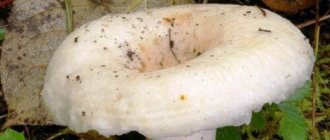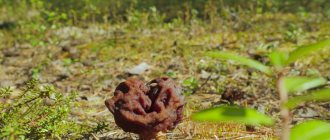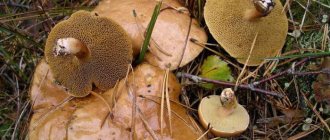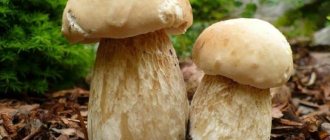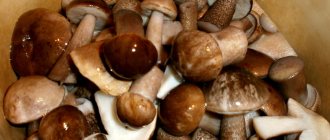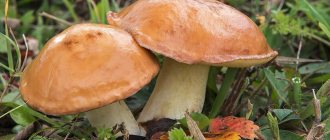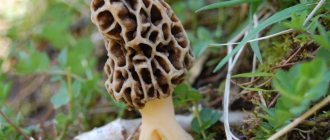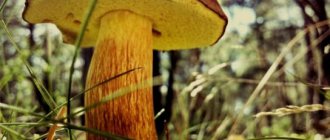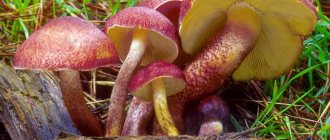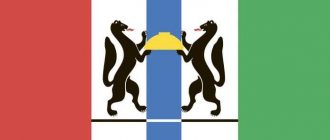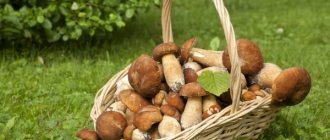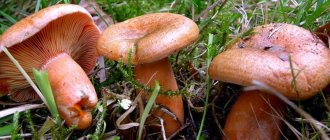Among lamellar mushrooms, immediately after saffron milk caps, according to any classification, there are always milk mushrooms. And according to the group of lacticians, they are, if not of the same blood, then quite close relatives. The milk mushroom received its name from the collective words of the ancient Slavic language; “Gruddie”, “breast”, which means pile, heap. Indeed, it’s as if nature specially collects these mushrooms in a heap, and if you hit the right place, the basket will immediately be noticeably replenished.
The aroma of milk mushrooms is strong and pleasant. And if you can’t smell another mushroom until you bring it to your nose, then milk mushrooms are fragrant even from a distance. In the old days, milk mushrooms and saffron milk caps were so isolated from other lamellar mushrooms that only they were considered worthy of having a name, while the rest were simply called “mushrooms.”
In total, several types of milk mushrooms are known: real, yellow, black, blue, aspen, etc. Let’s get to know them better.
Real milk mushroom
Milk mushrooms have always been highly valued. But of all their types, for most mushroom pickers the most desired and beloved is the real milk mushroom, or, as it is also called, raw milk mushroom.
When meeting him, the mushroom picker’s gaze immediately tenses; somewhere nearby there was probably another equally handsome man in disguise, and perhaps a whole large family. These short, milky-white, stout creatures with shaggy edges have their caps turned inward.
The hat is bright white, slips in the hands even in dry weather, and that is why it sparkles like mother of pearl. No other mushroom has such pure whiteness as a real milk mushroom.
Real breast milk (Lactarius resimus)
Most often, raw milk mushrooms can be found in birch, pine-birch forests, but can also be found in aspen forests, even in spruce-pine plantations with sandy and sandy loam soils and with hilly terrain. This mushroom is practically not found in humid and damp places, and its rare appearance there can only be explained by certain weather conditions - very severe drought.
Frequent but short rains contribute to the abundant appearance of milk mushrooms. If the rains are prolonged and the soil is oversaturated with moisture, the mushrooms disappear. As the popular saying goes: the rains have been prolonged, so don’t expect milk mushrooms.
The cap of an adult mushroom is large, reaching 20 centimeters in diameter. At first it is almost flat, but as it grows it becomes funnel-shaped, with shaggy edges turned down. The flesh of the mushroom is always white, dense, with a specific aroma; it does not change color even when broken. The leg is relatively thick, up to 5 cm long, naked, white, hollow inside.
The low stem and constant moisture of the cap are the reason that the mushroom, as a rule, is always covered with forest debris - fallen leaves or needles, so you need to look for milk mushrooms very carefully. To avoid returning home with an empty basket, you should arm yourself with a wand - you can always use it to check any suspicious lump to see if there is any desired prey under it. You just need to use the stick carefully and carefully, you don’t need to be zealous and plow up the forest floor, almost digging it up. Break the needles, moss, leaves, you may find the long-awaited mushrooms, but you will leave behind a “scorched field” with dead mycelium.
The milky juice of milk mushrooms is sharp and white (it turns gray-yellow in air). Under the cap, white plates smoothly descend from the outer edge to the spine.
In the photo of a real milk mushroom, droplets of milky juice are clearly visible.
A real mushroom, thanks to the fringe located along the edge of the cap and consisting of many fibers, cannot be confused with any other mushroom. Among the poisonous and inedible, it has no counterparts.
The first milk mushrooms usually grow in the second or third ten days of August or September; their mass appearance usually coincides with the autumn leaf fall. But in some years, a powerful harvest wave of milk mushrooms can be observed as early as the end of July.
But in general, according to the existing phenological sign about the order of appearance of mushrooms, the rule is this: when the mushrooms appear, wait for the milk mushrooms.
Real milk mushrooms are collected and used only for pickling. Salted, they have a bluish tint, are very aromatic, juicy and meaty. Although many mushroom pickers are happy with any mushroom, only unovergrown ones with a cap size of no more than 10 cm are really good for pickling.
In the past, “commercial mushroom science” was developed in great detail, which every mushroom picker knew. For example, salted milk mushrooms were divided into 5 varieties:
- the first is the “sock” (very small, up to 3-3.5 cm, caps);
- the second - “vertical” (4-5 cm in size);
- the third - “half-quarter” (with a steeply turned plate of a cap with a diameter of 9-13 cm);
- the fourth – “slippers” (sizes from 13.5 to 20 or more);
- the fifth is “lomoviki” (weight scrap).
According to this classification, we see that nothing was lost from the milk mushrooms, even crumbled and broken mushrooms were also used! It’s not for nothing that real milk mushrooms are classified as category I mushrooms, i.e. to the favorites of mushroom cooking.
Since milk mushrooms have a caustic milky juice, before salting they are soaked for 2-3 days in cold water, and the water is changed 2-3 times a day.
Yellow breast
The yellow milk mushroom is very similar to its real counterpart and is practically no different from it in terms of taste. It also belongs to category I mushrooms.
It is characterized by a yellow-golden color of the cap; its shape is concave inward. The leg of the yellow milk mushroom is short, 4-5 cm long and up to 3 cm thick, narrowed downwards, mucous. The flesh of the mushroom is fleshy, elastic, white, but turns yellow when pressed. At the break or cut, a very caustic white milky juice is released, which turns yellow in the air. The plates are whitish or creamy, descending along the stalk. Spore powder is yellow.
Yellow breast (Lactarius scrobiculatus)
You should look for yellow milk mushroom, unlike its brother, not in birch forests, but in spruce or spruce-birch stands on moister and clayey soil. It grows mycorrhizally with the roots of spruce and is a typical coniferous mushroom.
The first specimens appear in August, and their massive growth occurs during the period of heavy leaf fall. Their harvest is not abundant. Some lovers of quiet hunting treat colored milk mushrooms with distrust, but in vain. The nutritional and taste value of this mushroom is excellent.
Like real milk mushrooms, this mushroom is good for pickling, and also with obligatory pre-soaking in cold water for 2-3 days to remove the milky juice. You can also marinate it.
Poisoning prevention measures
Not only false mushrooms, but also true mushrooms growing in areas with unfavorable environmental conditions can cause acute poisoning. When harvesting forest crops, pay attention to the presence of roads, factories, and industrial enterprises near them. Prevention measures:
- Collect only those mushrooms that you are absolutely sure of (be able to distinguish a real specimen from a false one).
- Do not cut mushrooms in places with high concentrations of toxic substances. These include industrial production, highways, highways, and chemical plants.
- Before cooking, milk mushrooms are washed and soaked for 3–8 hours, changing the water every 1.5 hours, then subjected to heat treatment (cooking, frying) or salting.
Blue breast
This milk mushroom has another name, and it’s quite offensive - dog milk mushroom. Why he was given such a nickname, no one can answer: dogs don’t seem to eat him, and in appearance there is also nothing similar to our four-legged friends. But as for turning blue, everything is clear here. This is due to the purple tint of the records and the same color of the juice. Purple, blue - for us this color is always suspicious, which is most likely associated with various kinds of bruises, swelling, and lights under the eyes. Probably for this reason, many mushroom pickers avoid this milk mushroom, considering it something like a toadstool. But in vain! This is a very good, edible category II mushroom.
Blue breast (Lactarius repraesentaneus)
This mushroom is quite rare. It can be found in deciduous, coniferous and mixed forests in moist areas of soil with a thick layer of fallen leaves.
The shape of the cap is similar to a real milk mushroom, and the color resembles yellow. And only the plates are colored in their own way. Its pulp is dense, white, and bitter. The leg is up to 3 cm thick and up to 7 cm long, pale yellow, loose inside. When ripe, it is hollow. When you press it it turns blue.
The mushroom is tasty when salted. It is of some value from a medical point of view, as it is a strong antibiotic, helping in the treatment of abscesses and sore throats.
Distribution and collection
The blue milk mushroom is not common, but is very widespread: it covers the entire northern hemisphere, including even Taimyr and Greenland. It can grow next to both coniferous trees (of which spruce is preferred) and deciduous (mainly birch and willow) trees. It often grows singly or in small groups.
Dog breast.
Fruiting in this species is short-lived: the end of summer – the very beginning of autumn.
Black milk mushroom
Many mushroom pickers know this milk mushroom as blackhead or gypsy. It is collected from mid-July until mid-October in coniferous and mixed forests. Black milk mushroom grows in open areas, along clearings and roads, near clearings.
Black milk mushroom (Lactarius necator)
The diameter of the cap can reach 15 cm, the height of the rounded hollow stem is about 6 cm, its diameter is 3 cm. The shape of the cap of a young mushroom is flat, with a small depression in the middle. With age, it becomes funnel-shaped. The color of the cap and legs is greenish-brown, greenish-black. The pulp is thick, but fragile, white in color, turning gray when exposed to air.
In some places, black milk mushrooms are unfairly classified as poisonous or inedible mushrooms. But in vain. This is an edible mushroom of category III, and in terms of taste when salted, it is quite a bit inferior to the real milk mushroom.
How to pickle raw mushrooms (milk mushrooms) in a hot way - a simple winter recipe in jars
Using this recipe, you will be surprised how delicious mushrooms can be!
Ingredients:
- Water;
- Salt;
- Bay leaf;
- Pepper;
- Mushrooms.
After washing the mushrooms well, they need to be boiled. After the liquid boils, remove the foam from its surface. Turn the heat to low and cook for about five minutes. Remove the pan from the heat, drain the water and leave the mushrooms to cool. In the meantime, make the brine: fill the container, add salt at the rate of 3 tablespoons per 1 liter of water. After waiting for it to boil, turn off the heat.
Place bay leaf and pepper to taste at the bottom of sterilized jars. Place the caps loosely next to each other. Fill with hot brine. The sample can be taken after forty days. And the preparations need to be stored in a cool place.
Oak milk mushroom
Prefers deciduous forests, especially oak forests in hazel thickets, and humus loams. It is collected from July to September.
The cap of the oak milk mushroom is up to 20 cm in diameter, fleshy, smooth, moist, slightly pubescent along the edge. In young specimens it is convex, with curved edges, and as the mushroom grows it becomes prostrate with wavy, curved edges. The color of the cap is red or yellowish. The stem reaches a height of 9 cm; in young mushrooms it is solid, in adults it is hollow. The pulp is fleshy, fragile, with a strong mushroom aroma. The milky juice is white and very bitter.
Oak breast (Lactarius insulsus)
Oak milk mushroom is assigned to category II. Recommended for pickling with pre-soaking.
Taste characteristics
Milk mushrooms are rich in protein, microelements, and vitamins.
They are low in calories but high in nutritional value. They are not suitable for frying, but they are ideal for pickling. Even after prolonged processing, the flesh of the black milk mushroom remains elastic and dense, so it crunches on the teeth. These mushrooms retain their shape and always look beautiful on the table. They have a unique “mushroom” aroma, and the taste is rich and bright. The best taste of black milk mushroom appears at the stage when the cap is still small and just beginning to form a funnel. At this moment, its edge part is still bent inward, and the plates are even and have a light shade. Large specimens accumulate the carcinogen necatorin and become bitter in taste. When attacking a large group, you should not be greedy. It is worth collecting only young representatives, and it is better to leave the old ones in the forest.
Aspen milk mushroom
Aspen (or poplar) milkweed is found singly or in small groups in damp aspen or poplar forests. It is collected in July - September.
The cap of this milk mushroom is off-white in color, with brownish or pinkish spots and darker concentric zones. Pink plates. The leg is dense, short, white.
Aspen milkweed (Lactarius controversus)
The pulp is pungent in taste, with a pungent odor, and pink in color.
This mushroom belongs to category II. Traditionally it is salted.
Pepper milk mushroom
This species is found mainly in small families from mid-July until frost. Prefers deciduous forests with a predominance of oaks or birches.
The surface of the cap is smooth, matte, dry. In a young mushroom it is beige in color, but over time it becomes light yellow with brown spots. The diameter of the cap usually does not exceed 15 cm. The rounded leg has a height of about 8 cm and a diameter of about 3 cm. It differs from other milk mushrooms in the absence of concentric zones.
Pepper milkweed (Lactarius piperatus)
This species belongs to the IY category of mushrooms. Suitable for pickling.
Loads
Milk mushrooms, as already mentioned, belong to the group of milkweeds. That is, when they break, they always secrete milky juice. But the loads do not release such juice either at the break or at the cut. But in shape and appearance they are exactly the same.
Are milk mushrooms real? Some mycologists call them milk mushrooms, while others object, demanding that these mushrooms be defined exclusively as russula. However, lovers of quiet hunting themselves, leaving disputes to specialists about the clans of the mushroom kingdom, call the loads dry milk mushrooms. Our most famous podgrudok is white (cracker) and podgrudok is black.
White loader (cracker)
The cracker lives up to its name one hundred percent. His hat is dry, rough, matte white, and does not have any mesh fringe along the edge. The mushroom remains dry even when broken, although it has a characteristic mushroom smell.
The size of the cap, like that of real milk mushrooms, can reach 20 cm in diameter. At first the cap is flat, then it becomes funnel-shaped and turns yellow. What makes the cracker similar to a real milk mushroom are the brownish spots that appear on the cap. The plates are bluish-white. The pulp is white, dense, sweetish taste, does not change color when broken.
White podgrudok (Russula delica)
Inexperienced mushroom pickers often confuse mushroom pickers with real mushrooms. This mistake is also possible because the cracker, like its real brother, hides from the eyes of the mushroom picker under the forest floor. And it’s not easy to find a young seedling, because the fruiting body of the cracker begins to form underground.
In general, both mycologists and mushroom pickers have very contradictory opinions about it. Officially, it is included in the II category of mushrooms. However, some believe that the podgruzdok, if it is inferior to anyone in taste, is only to saffron milk caps, but not to milk mushrooms.
White podgruzdok is very tasty when salted. Some people prefer to eat it by boiling it in salted water, hot, with sour cream. You can also fry it, and it’s better not alone, but in company with other mushrooms.
Loader black
Another representative of milk mushrooms is the black milk mushroom. Its cap, from 5 to 15 cm in diameter, is first convex, and then depressed in the middle and funnel-shaped. In young mushrooms it is dirty gray, in adults it is brown or dark brown. The skin of the cap is slightly sticky to the touch and cannot be removed. The pulp is initially white, brittle, then brownish-gray, turns red when broken, and then turns black. The descending plates are whitish, grayish with age, and turn black when pressed. The leg is cylindrical, solid, smooth, the same color as the cap, and also darkens when pressed.
Black podgrudok (Ruussula aduusta)
Podgrudok black is a category III mushroom. It can be consumed fresh, salted, but always after preliminary boiling. It is not very popular among mushroom pickers due to its rather low taste, as it has a peculiar smell of damp earth.
Interesting Facts
Dog breast.
All information about the genus of milk mushrooms is fully applicable to the blue milk mushroom:
- All milk mushrooms are very nutritious and rich in vitamins and amino acids, and therefore can replace meat.
- These mushrooms can be eaten by people with diabetes, since milk mushrooms do not affect blood sugar.
- Salted milk mushrooms acquire anti-inflammatory properties.
- Milk milk prevents the formation of stones in the gall bladder and kidneys.
- In particular, some sources call dog milk mushroom the best antibiotic (from edible mushrooms).
- Milk mushrooms contain vitamin D, which helps the body absorb calcium and has a beneficial effect on the condition of nails and hair.
- Milk mushrooms are used in folk recipes for pulmonary diseases.
At the same time, milk mushrooms, including this type, should not be given to children up to school age, since their digestion is difficult due to the presence of a large amount of chitin. For the same reason, those who suffer from digestive problems should not eat mushrooms. Also, if you have had allergic reactions to mushrooms before, you do not need to use them again.
Salting milk mushrooms requires adherence to a certain technology, since errors in the recipe can lead to the introduction of clostridia bacteria, which produce botulinum toxin, which, when ingested, causes a deadly disease - botulism.
